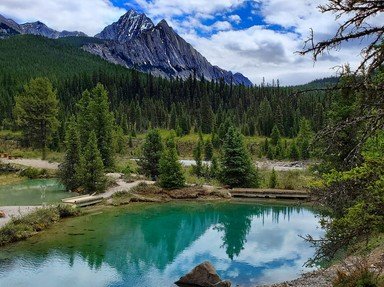Quiz Answer Key and Fun Facts
1. When it comes to the province of Alberta, Canada, food has a corner of its own, and food aficionado Cymraumbyth poses a question on that topic.
"Alberta is home to an internationally renowned ice cream store. Where in Alberta would you have to go to join the long line up for a Mackay's ice cream cone?"
2. For Quiz Makers Guild member stuthehistoryguy, Alberta, Canada is all about sports:
"The most venerable professional wrestling promotion in this beautiful, independent province is Stampede wrestling, which put on great shows from its establishment in 1948 until its closure in 1990. Though inactive through most of the 1990s, Stampede Wrestling began promoting shows again in 1999. What well-known wrestling family has operated Stampede Wrestling since its inception?"
3. Football fan joemc37 poses the next Alberta-centric question:
"What Edmonton Eskimos QB won 5 consecutive Grey Cups from 1978-82 and became the first player to ever be inducted into both the Canadian Football and the U.S. Pro Football hall of fame?"
4. Guild member apathy100 is a history buff with a question about a tragic incident in Alberta, Canada's past:
"During the 20th Century, the greatest landslide in North American history occurred in 1903 in the small town of Frank, Alberta. What was completely buried as a result of this tragic historical moment in Alberta's history?"
5. Our own spanishliz turns her attention to more recent history:
"In need of a place to train their armoured troops, after Gaddafi's 1969 coup denied it the use of the Libyan desert, the British Army looked to the open spaces of Canada. They found a home for the unit, known as BATUS, at a Canadian Forces Base in Alberta. Which one?"
6. Guild member skunkee has first-hand knowledge of the great province of Alberta and even knows a few of its secrets. She poses a question about one of its more unique spots:
"With a landscape that would look equally comfortable on the moon, or in the depths of Death Valley, this part of southern Alberta has to be seen to be believed. Its bleak, windblown terrain, carved by water over 70 millions years ago, offers a sharp contrast to the rich grasslands around it. What is this area of Alberta called?"
7. Ah, leave it to the scholarly CellarDoor to come up with a question combining history and etymology.
"The name "Alberta" was bestowed upon this large region before it had even become a province," she says. "Unlike the names of neighbouring lands, "Alberta" came not from a First Nations word but from the name of a popular member of the British royal family. In whose honour was this land christened?
8. Not surprisingly, Guild member gretas is interested in Alberta's connection to pop culture.
"Alberta is home to more than just rich history and amazing geography," she insists. "It is also the birthplace of a well-known comic book hero. Which comic book icon, who has also been portrayed in several successful films, was "born' in Alberta?
9. Guild member Bruyere's question showcases her domestic side.
"Alberta Province is known for its production of canola oil as it produces 34 percent of the product for Canada. Which of these is NOT true about this oil?
10. Guild member Leo Da Vinci takes us back to Alberta's prehistoric era with his question:
"In the bleak, barren, weather-beaten valleys of Alberta, a large concentration of dinosaur fossils were uncovered. This spawned the creation of Dinosaur National Park. Over 150 complete skeletons have been uncovered, and countless other various bones as well. Which of the following families of dinosaurs can NOT be found at Dinosaur National Park?"
Source: Author
gretas
This quiz was reviewed by FunTrivia editor
minch before going online.
Any errors found in FunTrivia content are routinely corrected through our feedback system.

